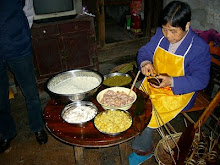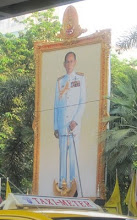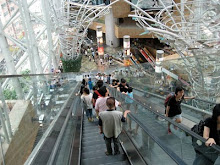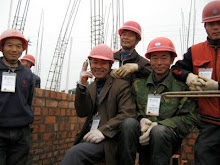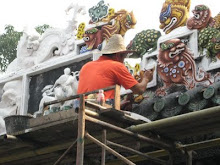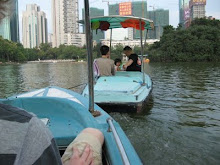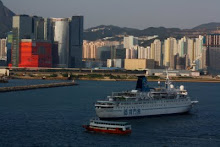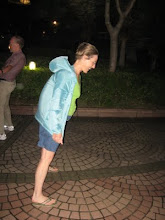Wednesday, April 14, 2010
Pak's gastronomic excursions always have settings and this one was to occur in East Mongkok, in the neighborhood of the goldfish market. When he was younger, he had gone there regularly to buy fish. There are lots and lots of small stores selling innumerable, magically colored varieties of fish, plus all the required accoutrements.
It is in a relatively run-down neighborhood and so perfect for good cheap restaurants.
Pak decided that, since it was the 15th and many people would be avoiding meat, we should go to the vegetarian restaurant first before it got too crowded. Unfortunately, when we got there, we discovered that the restaurant had changed and was now heavily centered on meat. We decided to move on to Pak's second choice, which focused on food from Yunnan Province. But that also no longer existed. This is not an uncommon occurrence in Hong Kong, where restaurants change with great rapidity. So we crossed the road to eat at a dumpling restaurant.
It turned out that it was part of a chain, a Chinese variety of fast food. They sold about five different kinds of dumplings that could be had boiled or fried. You selected one or two kinds of dumpling and combined it one of five kinds of soup. Very simple and formulaic, but very tasty also. I had hot and sour soup for the first time in Hong Kong. All of the dumplings had meat in them, but Pak had decided that he had met his religious obligations by searching out the other restaurants. He could not be blamed for the fact that they no longer existed and he was being forced to eat meat.
There were several elements of the dumpling restaurant that interested me and can be contrasted with US fast food. First, one of the employees was sitting there, busily stuffing and folding dumplings. We asked her where the wrappers came from and found they were made at their central facility. In the US, everything would be made at the central facility and delivered frozen to the outlet. Then the serving dishes, plates, bowls everything were real china or plastic, nothing disposable. It's often difficult even to get a napkin in a restaurant here, but that's another story. The chopsticks, spoons and small bowls were kept in drawers within the tables; you just open up and take out what you need.
Having finished lunch proper, it was time to search out the stinky tofu restaurant. Part of me was hoping that it would have met the same fate as the other restaurants, but soon I could tell that was not the case. The unmistakable odor became apparent amidst all the other street smells. It grew stronger and stronger until we reached the storefront. It seemed like they had a variety of things available, including sausages and animal parts, but we were single-minded. For HK$6 (less than a buck) I got a brown paper bag containing a 2 inch cube of the magic stuff on a stick. It had been deep-fried a toasty golden brown. By this time, we had started to become accustomed to the smell. Texturally, this food is good. A nice crunch to the outside, with soft and creamy inner parts. Unfortunately it tasted just like it smelled and as I started to eat it, the taste and smell combined synergistically in a rather unpleasant way. Fortunately there were several condiments available, both sweet and savory. I found that the hot sauce was pretty effective for masking the flavor, though it could not override the smell. Pak assured me that I was not required to finish the whole thing. I heartily agreed with him and jettisoned the rest of it in a handy garbage can.
I asked Pak why people ate it; did it have some perceived medicinal benefit? He said no, it was just that some people liked to live on the wild side. Stinky tofu is outside of normal behavior and consumed by people who like to be a little outrageous. I have a wide definition of food, but this was a little much for me. The soft inside part was full of gas bubbles from active fermentation. No wonder the smell was so powerful. I wondered which bacteria were responsible and hoped that they had all been killed by the frying process
We had agreed that this was to be a three-part adventure so now we went in search of Chinese dessert. As I said, Pak always has something in mind and he was looking for something in particular here. He found it, with a little directional help from some street vendors, - the Yee Shun Milk Company. I had seen these places before, though never been in. Their windows are filled with dishes of various puddings/custards. Milk-based puddings did not seem very Chinese to me, but apparently these places, which originated in Macau, have been around a long time. But they definitely represent a fusion between East and West. The menu also included fried eggs and sausage and sandwiches. But we were after desert. We both got steamed milk; Pak's was flavored with ginger. I thought of it as something you might be fed in a British convalescent home. Very nutritious with all those milk and egg proteins but easy to get down. It was softly set, nicely flavored and not too sweet; the perfect antidote to stinky tofu.
Friday, April 9, 2010
Touring China
My brother Stuart and his wife, Corky came to visit us in Hong Kong. Stuart has recently retired and so they took the opportunity to come here and then travel through China. Their trip through China was organized through a tour company and we joined them for the first leg of the trip, to Guilin in southern China. It was interesting to compare this kind of traveling with the youth hostel, figure it out on the fly approach we used for our last big trip to China.
This kind of touring was not the busload of gawking foreigners approach. It just meant that we had a guide and a driver, with accommodation and meals arranged.
At our suggestion, the first leg of the trip to Guilin was by train, so that S&C could experience first hand this kind of travel in China. Its interest started the week before they got here, when the tour company emailed Stuart to say they had been unable to get soft sleeper tickets originating in Shenzhen (just across the border from HK) and could we start from Guangzhou instead. That's just a 2 hour train ride up from HK and so not difficult, but what is interesting about it is that the train we could not get on in Shenzhen was exactly the same train we ultimately did board in Guangzhou. So our soft sleeper berth went from Shenzhen to Guangzhou empty, while we followed the same route on a different train. I assume it is something to do with ticket quotas available in different towns.
Having a guide and driver available is something that I could get used to. It is feasible, even for a small party, because wage rates in China are relatively low. With our lack of Mandarin, there is always so much we miss when traveling in China and so here we always had somebody to whom questions could be addressed. Of course, you have to bear in mind that you are getting one person's version of the world so statements have to be interpreted with caution. But S&C had done their homework well and selected good and interesting places to visit and we were delivered to them with great efficiency and ease.
The area is very touristy but with good reason. A lot of those classical pen and ink Chinese paintings are from here, with the limestone karsts rising vertically and spectacularly out of the otherwise flat landscape. Absolutely beautiful, but a little too touristy for me, especially Yangshuo. Except for the Chinese characters on the buildings, I felt like I could have been just about anywhere (e.g. the White Mountains of New Hampshire. The landscape was different but the tourist pedestrian street was the same. But actually, it did not take too much scratching beneath the surface to find the differences. I always like to get to the food markets in these places and this one was easy to find, in a large single storey building just off the main street. There was a sign close to the entrance, interestingly in English as well as Chinese, advertising a restaurant serving dog meat. And there, buried in the back of the market, alongside the live chickens and ducks and rabbits, were the dogs. I first caught sight of one whose throat had just been slit and was bleeding out. That was right next to several cages with light colored mongrel dogs. One of the things our guide had told us was that people think light furred dogs taste better than dark colored ones. Seems unlikely, but who knows? I ate dog meat in Beijing, but that was cooked on a stick and quite different from seeing the animals being killed up close. I am not sure for me whether it was any different from seeing a sheep or a pig have its throat cut. Getting that close to the reality of being a meat eater is never easy, but I think quite useful.
On the subject of food, the downside of being on the hands of the tour company was the places they took us to eat. The hotels are safer from several perspectives and are happy to bill the tour company. But the food reminded me of the kind you get at generic Chinese restaurants on the West. And despite going to different restaurants, they get serving us the same food (corn soup, beef with onions and peppers, egg fried rice). It came to a head quite hilariously when we were served French fries, though with that funny sweet sauce they often serve with the prawn crackers at the beginning of Chinese meals in the USA, rather than ketchup. After that, we did manage to impress on the guide that we would like more interesting food and it did get better.
It was eye-opening to be traveling with Corky, who has both balance and endurance issues and cannot walk far or climb stairs easily. Neither China or Hong Kong is set up well for people with disabilities and it took us all some time to figure out good ways of dealing with it.
We were in Guilin/Yangshuo for 4 days before S&C took off for Shanghai/Xi'an/Beijing and we took the train back to Shenzhen. That was an interesting coda to the trip. We had been thinking we would just get the train tickets from the tour guide and make our own way to the station. But he seemed to want to take us there and so we arranged to meet him at a downtown hotel an hour before the train was due to leave. We arrived at the station and he dropped us off at the entrance for soft-sleeper passengers (yeh, for the class system of Chinese train travel!) while he went to get the tickets. He came back to tell us that we would be getting the tickets on the train. A strange idea to us that also meant we were barred from the soft sleeper waiting area. We were taken to another waiting area where we met the tour agency's train ticket guy. He looked just like the sort of person who would be touting tickets outside sporting venues in the USA, where you would worry whether the tickets you might buy were legitimate. He did not speak English (at least to us) but the guide told us that all the tickets to Shenzhen were sold out, but this man knew how to buy them on the train. There were always some available from the train staff and we would have no problem. It was fascinating to watch the ticket guy working. His eyes were always flitting around, sizing up the situation. Certain individuals would be selected as being important (e.g. a policeman) and he would sidle up and engage them in conversation. Part of the ritual was to offer a cigarette that would be stored for later use.
At a certain point, we were given the sign and walked quickly through to the platform, at the head of the line. Magically, nobody asked to see our tickets. The person in charge of the train was quickly located, given a cigarette, and we were invited to wait in the dining car of the train. After a while, another train person came and sold our guy two soft sleeper tickets. They were in car 2, which seemed unusual since the soft sleeper carriages are usually in the middle of the train, close to the dining car. We were delivered to our berths and the guide and ticket guy took their leave. We were the only people in the entire carriage, which also appeared to lack some of the attributes of the typical soft sleeper, e.g. carpet on the floor in the corridor. It turned out that we were being housed in the train's staff quarters. A mother and child came to share our compartment, but everybody else was train personnel. I think we had been sold empty slots rather than taking somebody's bed, but I have no idea who got the money. So it worked out fine in the end. Actually much quieter and more peaceful than the average Chinese train trip. I suppose it also shows the advantage of using tour companies. We would never have gotten on to that train without them.










